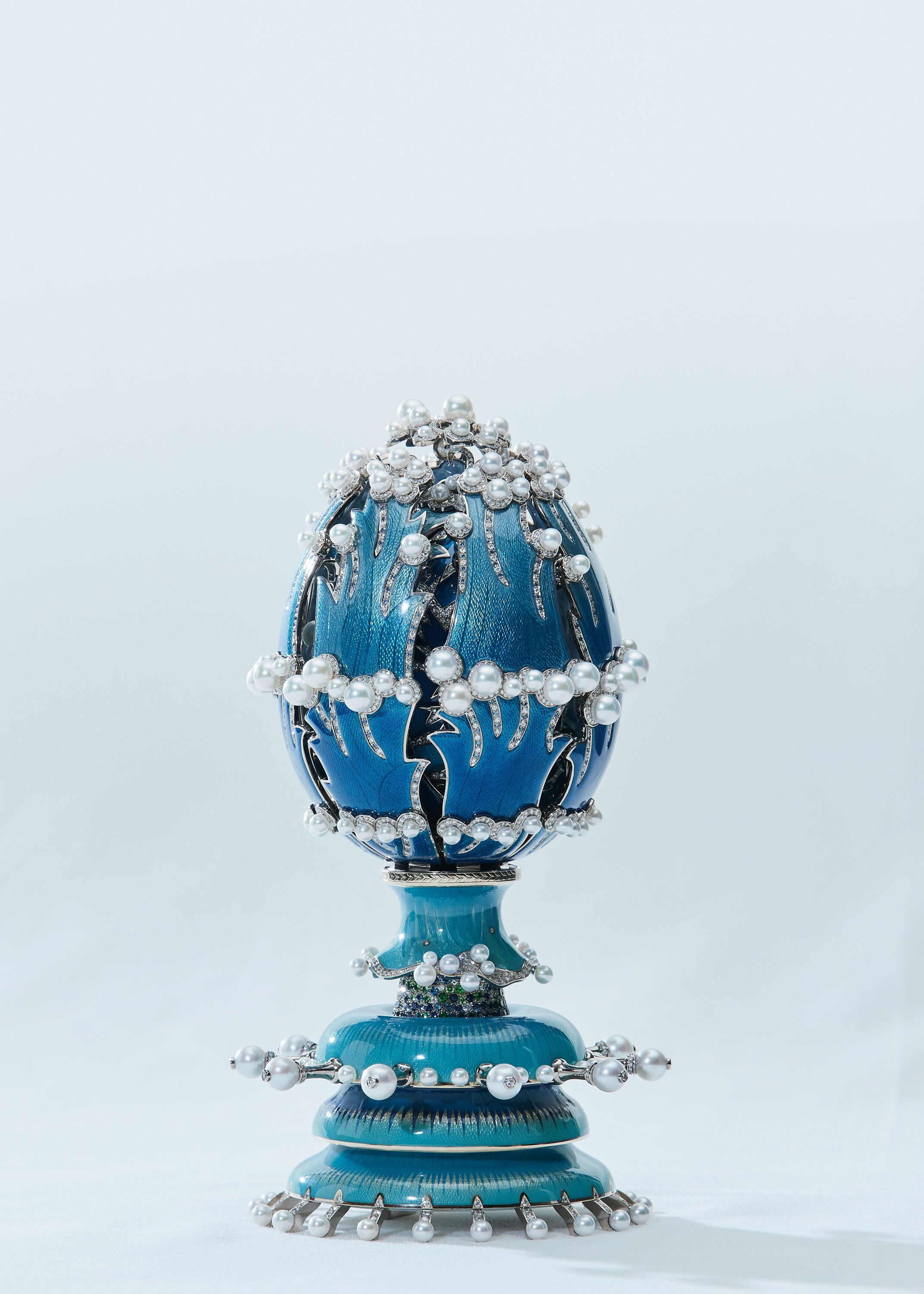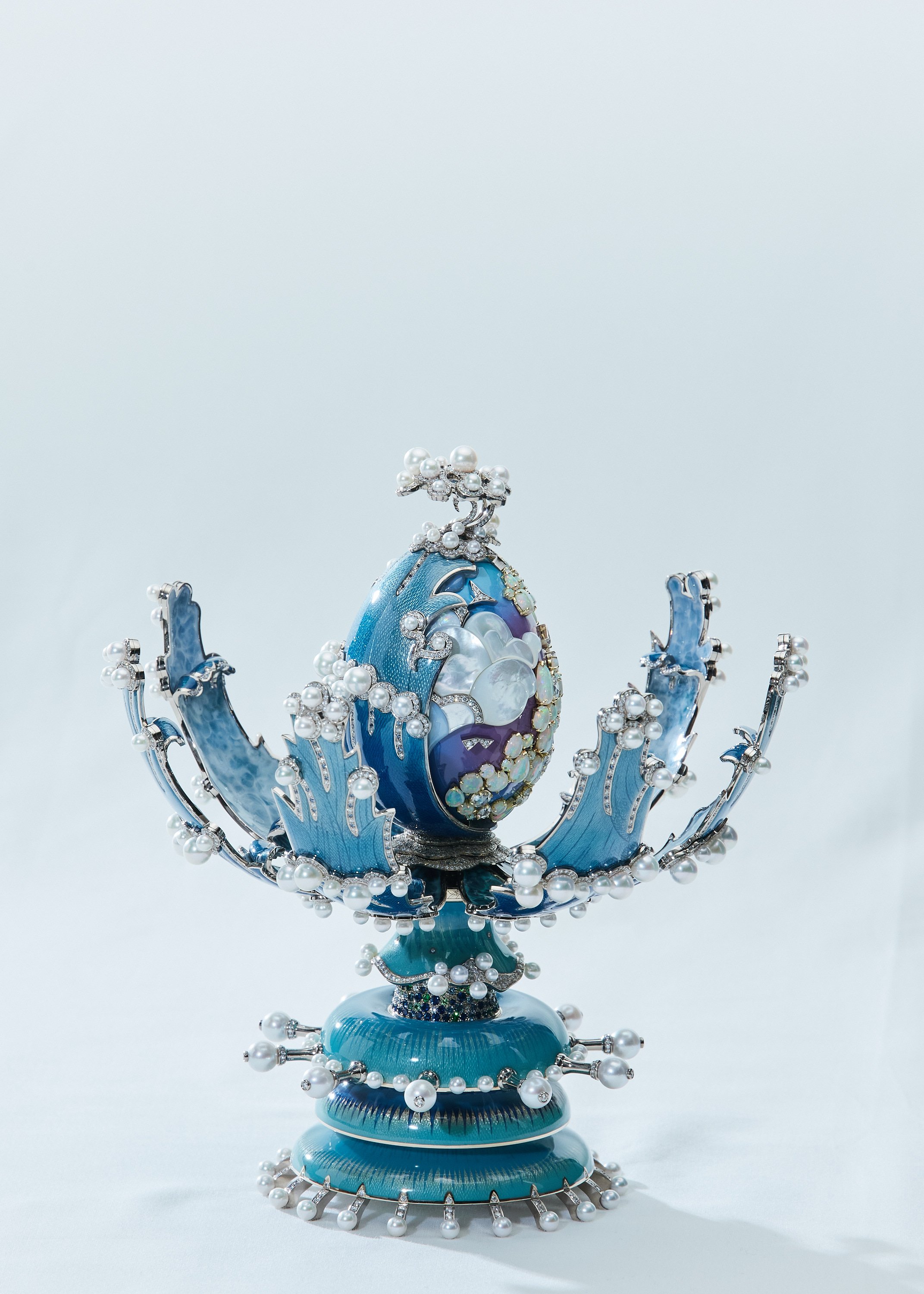FABERGÉ X REGENT SEVEN SEAS CRUISES ‘Journey in Jewels’
An exclusive egg has been created by Fabergé, the most famous artist jeweller in the world, in collaboration with Regent Seven Seas Cruises, the most prestigious luxury ocean cruise company in the world. The Seven Seas Grandeur, Regent’s newest vessel, features the Fabergé x Regent ‘Journey in Jewels’ Egg Objet, the only Fabergé egg to ever be permanently housed at sea, and the crown jewel of Regent’s 1600-piece art collection.
The Regent chose Sarah Fabergé, a Founding Member of the Fabergé Heritage Council and the great-granddaughter of Peter Carl Fabergé, to be the godmother of the Seven Seas Grandeur. At the christening ceremony in Miami, Florida, on December 10, 2023, she unveiled the ‘Journey in Jewels’ egg.
Sarah attended the posh gala as Godmother, donning her one-of-a-kind Fabergé x Regent Earrings and Ring, which were modelled after the brand’s ‘Journey in Jewels’ collection. The proceeds from the auction will go to the Gemfields Foundation.
“I am honoured to have been chosen as Godmother to this exceptional new ship, which, like Fabergé, has been inspired by the past and reimagined for the future,” said Sarah Fabergé.
Sarah Fabergé, in her role as godmother, will lead a Fabergé Spotlight Voyage on board the Seven Seas Grandeur beginning July 1, 2024. Guests will be immersed in the Fabergé world during this voyage, which will include master-class programmes for small groups, exclusive shore-side tours, jewelled egg demonstrations, lectures, and screenings.
The one-of-a-kind Fabergé x Regent ‘Journey in Jewels,’ made in England, takes its design cues from the seven seas that Regent’s ships sail. It showcases a plethora of vibrant gemstones that reflect the ocean’s hues, as well as guilloché enamel and ombre lacquering, which stand in for the waters and the sunrises and sunsets that passengers on Regent’s ships see.
The Fabergé x Regent ‘Journey in Jewels’ Egg Objet, created by Fabergé’s Head of Design, Liisa Tallgren, and supervised by Fabergé’s Creative Director, Josina von dem Bussche-Kessell, was made using traditional methods at the workshop of Fabergé Workmaster Paul Jones in southern England. Jones also worked on the egg objets for Fabergé’s collaborations with Game of Thrones and Rolls-Royce Motor Cars. About fifteen months have passed since the original concept for “Journey in Jewels” was conceived.
Enamelling an ombre of blues onto the egg’s outside “shell” makes it look like the ocean. An astonishing artistic achievement, this “shell” is composed of seven complex blades that, like crashing waves, each split into a “sea foam” of pearls and white diamonds at their points.
Set in Fabergé’s ‘Emotion’ pavé technique, the gigantic egg rests on a pedestal embellished with emeralds, tsavorites, blue sapphires, and white diamonds. The gems were hand-picked to capture the essence of the ocean’s vibrant colours. A stand with diamonds and pearls adorning the borders holds the gem-set plinth in place in the shape of the Seven Seas Grandeur ship’s helm. The overall design is more geometric and symmetrical.
More goes into these Fabergé eggs than is first apparent. With a gentle anticlockwise rotation of the pearl ‘helm,’ the seven blades—a number selected to symbolise the’seven seas’—open in harmony to unveil a secret within.
When you crack open the egg, you’ll see the intricate lacquering on the inside of the blades, which mimics the look of water ripples. At regular intervals, diamond-set wave crests evoke seascapes. It takes a lot of practice and years of schooling to master this lacquering method.
The Fabergé surprise inside the egg will captivate you when you open it. It’s another hand-painted egg, surrounded by a “wave” that gently spins, exposing the gradient of colours that represent the sunrises and sunsets at sea, as well as seasonal elements that you can experience on Seven Seas Grandeur. The Fabergé Winter Egg from 1913 served as inspiration for this egg’s dazzling gemstone decoration, which includes a diamond-set frost pattern that encircles the egg surprise. Alma Pihl, a Finnish woman who collaborated with Fabergé, created the sorrowful Winter Egg.
Peter Carl Fabergé was an innovator and risk-taker; it was already rare for a woman to be present in the workshops in the early 20th century, much less to assume the role of designer. However, he praised Pihl’s abilities, and she subsequently made some of Fabergé’s most renowned works prior to 1917. Female designer Liisa Tallgren, who was born and brought up in Finland, is carrying on Pihl’s legacy as head of design at Fabergé.
As the egg spins, white opals set in 18k yellow gold and hand-carved mother-of-pearl clouds appear; the opals symbolise rainbows formed by the collision of different meteorological conditions, and the warmth of the yellow gold conjures the sunshine.
Fabergé has accomplished two firsts: first, the egg has been decorated using the intricate process of ombre lacquering; and second, a unique custom mechanism has been designed to power the rotation of the inside egg surprise. Paul Jones, who has worked at Fabergé for over 40 years, has overseen the complex construction of this mechanism, which has taken months to perfect.
On average, it takes Jones’s tiny team of artisans ten years to learn how to hand-paint in an ombre style of lacquering, and even fewer of them have expertise with this method. If you want your lighter and darker blue shades to mix seamlessly, you’ll need to choose colours that melt at around the same temperature and build the ombre effect layer by layer.
Another feature that gives the egg its nearly liquid appearance is the blue guilloché enamel. The Maison takes great pride in carrying on Peter Carl Fabergé’s heritage as an innovator in the field of enamelling, an age-old process that he popularised with the introduction of more than 140 new hues. As amazing as it may sound, enamelling involves bonding powdered coloured glass to a surface using heat at about 800 degrees Celsius. It’s a delicate technique, and if you leave it in the kiln for even a second longer than necessary, you’ll have to start the process all over. Translucence, achieved by applying at least three coats and burning the egg in the kiln five times, is essential for highlighting the intricate design on the egg’s exterior blades, stand, and “helm,” as well as the enamel’s reflective properties.



